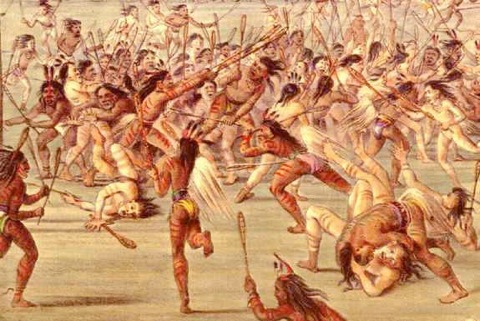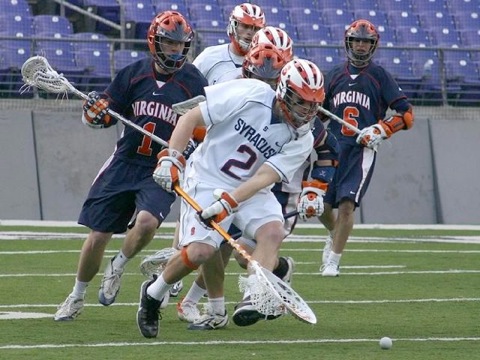Lacrosse is a sport played using a stick with a net on the end, called crosse, which players ue to carry a ball and try to toss it into goal. It can be played outdoors or indoors. Outdoors it is lpayed on a field of grass or artificial turf. Indoors it's played on clay.
In men's lacrosse, players wear protective equipment on their heads, shoulders, arms and hands, as body- checking is an integral part of the game, and stick checks to the sticks and gloves holding the stick are legal. Wearing helmet and gloves are mandatory and usually it's required to play in shoulder and arm pads. Sometimes they wear rib pads and other athletic supporters are also strongly recommended and often required.
Players of women's lacrosse (in the United States only) need only wear protective eyewear and mouthguards (except the goaltender, who wears additional padding, usually consisting of a throat protector attached to the helmet, chest pad, most goaies do not wear arm pads or shin pads), as contact is not permitted.
The safetyness of the lacrosse players is not only secured by the protective equipments but by the detailed rules as well. The player who commits a foul is penalized by a 1, 2 or 3 minutes penalty regarding to the heavyness of the foul. During the penalty the oponent plays in man advantege.
The object of the game is to put the small, solid hard-rubber ball into the goal of the opponent as many times as possible. The field of play is 110 yards (100 meters) long and 60 yards (54 meters) wide. The goals are 6 feet (1.8 meters) by 6 feet, containing a mesh netting similar to an ice hockey goal. The goal sits inside a circular crease, measuring 18 feet (5.5 meters) in diameter. The game is 60 minutes long, with 15 minute quarters. (In the Canadian box lacrosse - the Canadian version of the indoor lacrosse - there are three 20 minute periods.
Each team is composed of 10 players on the field at a time: three attackmen, three midfielders, three defenders and one goaltender. Women's lacrosse is played in a similar manner except with two additional midfielders per team. If the goaltender leaves the crease considered as any other player.
At the same time there are three attackmen on the field, there job is to get the ball in the goal of the opponent. Behind them there are three midfielders (also called middies), their purpose is to help the team both in offese and defense. The three defenders job is to protect the teams goal while the goaltender (also called goalie) stays in the crease and blocks the shots on goal.
During the whole game four players including the goalie have to remain in the defensive half of the field while three players have to ramain in the offensive half of the field.
In indoors lacrosse there are six players on the field in each team.

Eaxh player carries a lacrosse stick. There are short and long sticks. Short sticks are carried by the attackmen and the middies, long sticks are for the defenders. Even a midfielder may carrie long stick (he is the long-stick middie) with the restriction that the team may only have 4 long crosses on the field.
Players scoop the ball off the ground and pass the ball through the air to other players. Players are allowed to run carrying the ball with their sticks. Unlike in women's lacrosse, men's lacrosse players may kick the ball as well as cover it with their sticks, provided they do not withhold it from play. Only the goaltender may touch the ball with hands. During the game it's legal to substitute any time. That's important because on offense most of the teams use three short stick middies because of the better stick handling and quickness while on defense one of the midfielders is substituted to a long-stick middie to help the defense.
The play of lacrosse is quite fast and fluent, with considerably more goals scored than are in soccer or hockey, with typical games totaling ten or twenty goals.
Because of it'spectacularity lacrosse is one of the most popular games in Canada and even in the United State stands get full during the lacrosse games.
THE HISTORY OF LACROSSE
Among Native Americans, there were many versions of what we now call lacrosse. Players in some tribes used two sticks, one in each hand. Women and men sometimes competed together on the same teams, but women had their own form of the sport in some areas.
The Cherokees called the sport "the little brother of war" because it was considered excellent military training. A team consisted of hundreds, even thousands, of players, often an entire village or tribe, the goals were often miles apart, and a game might last as long as three days. Since most players couldn't get anywhere near the ball, they concentrated on using the stick to injure opponents.

The Six Tribes of the Iroquois, in what is now southern Ontario and upstate New York, called their version of the game "baggataway" or "tewaraathon". It was much more organized than in most areas of the country. There were 12 to 15 players per team, and the goals were about 120 feet apart.
According to most accounts, the first Europeans to see baggataway being played were French explorers who thought the stick resembled a bishop's crozier--la crosse, in French--so the sport was given a new name. However, the French played a form of field hockey that was called jeu de la crosse, and that's a much more likely origin of the name.
Early in the 19th century, Europeans in Canada began playing the game. Montreal's Olympic Club organized a team in 1844, specifically to play a match against a Native American team. Similar games were played in 1848 and 1851.
However, the first step toward turning lacrosse into a genuinely organized, modern sport came when the Montreal Lacrosse Club, founded in 1856, developed the first written rules.
George Beers of the MLC rewrote the rules thoroughly in 1867. His rules called for 12 players per team, and named the positions: Goal, point, cover point, first defense, second defense, third defense, centre, third attack, second attack, first attack, out home, and in home.
Beers, who is now known as " the father of lacrosse," also replaced the hair-stuffed deerskin ball with a hard rubber ball and designed a stick that was better suited to catching the ball and throwing it accurately.
Canada's National Lacrosse Association, which was also established in 1867, quickly adopted the new rules. The same year, a team made up of Caughnawaga Indians went to England and played a match for Queen Victoria. The sport became quite popular in Bristol, Cheshire, Lancashire, London, Manchester, and Yorkshire, and the English Lacrosse Union was organized in 1892.
Lacrosse in the U. S.
Lacrosse had pretty well died out in the northern United States by the middle of the nineteenth century, but it was revived in upstate New York during the late 1860s by the Onondaga tribe, influenced by the St. Regis tribe, which was among those still active in Canada.
White players in Upstate New York began to play lacrosse about 1868, and the sport soon spread to Metropolitan New York, where several teams were organized during the 1870s. New York University and Manhattan College played the first U. S. intercollegiate game on November 22, 1877, and other colleges in the Northeast soon took up the sport, including Boston University, Columbia, Cornell, Harvard, Princeton, and Stevens Institute.
The U. S. Amateur Lacrosse Association, founded in 1879, adopted the Canadian rules. Seven colleges formed the first Intercollegiate Lacrosse Association three years later. That was succeeded in 1905 by the Intercollegiate Lacrosse League, which changed its name to the U. S. Intercollegiate Lacrosse Association (USILA) in 1929.
Ice hockey and lacrosse have always been closely connected. In fact, the original rules of ice hockey, written in 1867, were patterned after those of lacrosse, and most hockey players in Canada also played lacrosse.
Johns Hopkins University in Baltimore was a major hockey-playing college in the 1890s. Lacrosse was introduced there in 1893 by some students who had seen the sport on Long Island, and it quickly became very popular throughout Baltimore. Programs were developed for all age groups by 1900 and the city has been a hotbed of lacrosse ever since.
Although there are large areas of the country where lacrosse is virtually unknown, it has become quite popular in many other areas, including Long Island, Upstate New York, Indiana, Michigan, Northern California, Oregon, Florida, Texas, and the Atlanta region.
A national collegiate champion was chosen by committee until 1971, when the NCAA began conducting its annual championship tournament. The Division III championship was added in 1980. The NCAA Division II championship was conducted from 1974 through 1982 and it was resumed in 1993 after a twelve-year hiatus.
At many schools, lacrosse is a club sport--that is, it's run by students independently of the athletic department. Club teams even coexist with varsity teams at quite a few colleges. The USILA conducts a national championship tournament for college club teams. The National Collegiate Lacrosse League, founded in 1991 as an organization of about 70 schools with club teams, also has a championship tournament.
Since 1934, the U. S. Lacrosse Association has conducted the U. S. Open tournament for post-collegiate club teams.

Indoor Lacrosse
An indoor version of lacrosse, known as box lacrosse or "boxla," was developed in Canada during the early 1930s. Played in hockey rinks with six-man teams, it became very popular throughout the country and was the dominant form of the sport in Canada by the end of the decade.
The Mann Cup, originally donated by Sir Donald Mann in 1910 as a challenge trophy for the Canadian amateur champion team, was transferred to box lacrosse in 193?
Outdoor lacrosse has made something of a comeback in Canada, spurred in part by the establishment of the Internaitonal Lacrosse Federation and the world championship tournament in 1967. However, box lacrosse is still far more popular than field lacrosse in Canada.

In 1986, the Major Indoor Lacrosse League (MILL) began operating with six teams in the United States, playing a form of the sport very similar to boxla. The MILL has an unusual structure in that the league is owned by three partners, while teams are operated by local organizations that have no ownership position.
That structure gave the MILL stability, since the failure of one or two franchises couldn't drag the entire league down. However, it also made expansion difficult, if not impossible.
The National Lacrosse League (NLL) was organized in 1997 as a group of independently owned teams to begin play the following year. After much negotiation, the MILL merged into the NLL, which played its first season in 1998.
Women's Lacrosse
Although lacrosse didn't become very popular as a men's sport in England, it was adapted for women's play during the 1890s, mainly because it was seen as the ideal spring sport for women who played field hockey during the fall. While men's lacrosse is very similar to ice hockey in many respects, women's lacrosse was patterned after field hockey, in which body contact is strictly forbidden.
Constance M. K. Applebee of England introduced field hockey to American women in 1901 and she remained in this country as a physical educator, teaching the sport at several schools and at a summer camp that she established in 1922.
She was also active in establishing lacrosse as a women's sport in this country. The U. S. Women's Lacrosse Association was founded at her camp in the summer of 1931. The USWLA governed the sport on the collegiate and club levels until 1981, when the NCAA inaugurated its national championship tournament for women.
A Division III championship was established in 1985. The National Collegiate Championship is for Division I and Division II schools.
International Lacrosse
Lacrosse, as already noted, was introduced to England in 1867. From England, it spread to Scotland, Wales, Ireland, Australia, New Zealand, and South Africa.
It was an Olympic sport in 1904 at St. Louis and in 1908 at London. Only three countries, Canada, England, and the United States, were represented and Canada won both gold medals.
Lacrosse was a demonstration sport at the Olympics in 1928, 1932, and 1948, and an exhibition tournament was held at the Los Angeles Olympics in 1980. A few other countries, most notably Germany and Japan, have taken up lacrosse, but there are still not enough national governing bodies to warrant its consideration as a full-fledged Olympic sport.
The International Lacrosse Federation has conducted a men's world championship tournament since 1967. The women's world championship, inaugurated in 1969, was replaced in 1982 by the World Cup tournament for women.
(Source: HickokSports, Wikipedia, Jim Anderson - Sherwood High School)